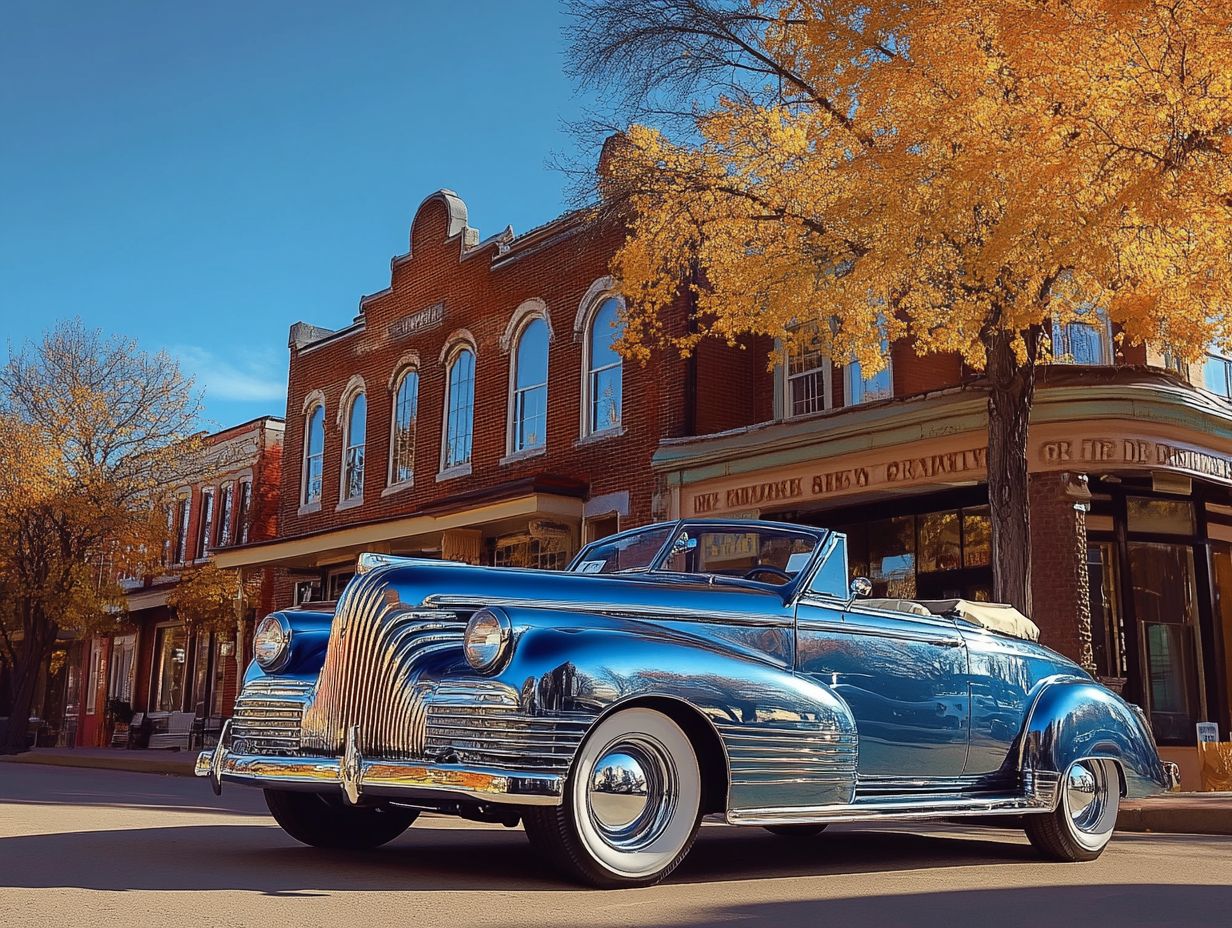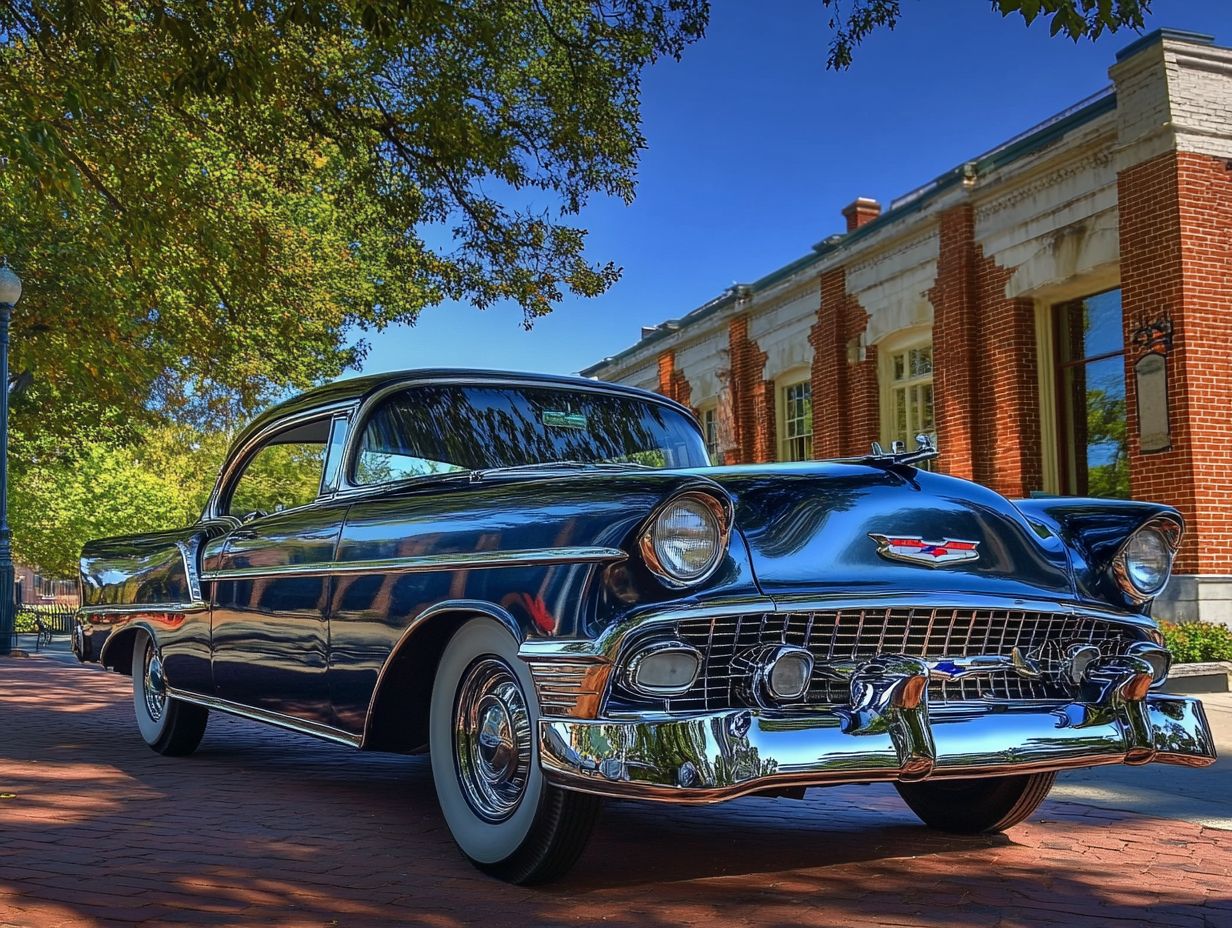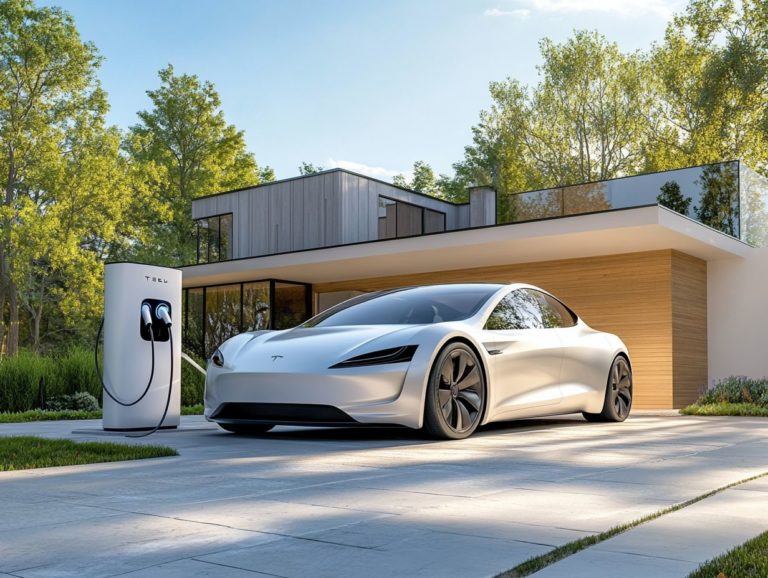What is Coverage for Antique Cars?
Antique cars are more than just vehicles; they are cherished treasures that deserve the best insurance to protect their value and history! Grasping the nuances of antique car coverage is crucial for safeguarding your investment.
This article delves into what qualifies as an antique car, examines various coverage options, and underscores the key factors that influence your policy. By the end, you’ll possess the knowledge needed to navigate the realm of antique car insurance with confidence.
Contents
Key Takeaways:

- Antique car coverage provides protection for a unique type of vehicle that holds both sentimental and financial value.
- There are different types of coverage options for antique cars, including agreed value, stated value, and actual cash value.
- Factors such as the car’s age, condition, and usage can affect the coverage and premiums for antique car insurance.
Understanding Antique Car Coverage
Understanding antique car coverage is crucial for car enthusiasts eager to safeguard their collectible vehicles, including vintage motorcycles, classic cars, or muscle cars.
Antique car insurance stands apart from standard auto insurance, featuring specialized policies crafted to address the unique needs of antique cars. This coverage for car enthusiasts ensures your treasured possessions are well-protected against potential risks.
Limited use means the car is driven infrequently, while secure storage means keeping the car in a safe place when not in use. Leading insurance companies, such as State Farm, offer tailored plans that cater to your specific needs, making it easier for you to maintain both the condition and value of your vehicles.
What is an Antique Car?
An antique car is typically seen as a vehicle that s at least 25 years old. Think classic cars, vintage motorcycles, and muscle cars. These automobiles serve as more than just historical relics; they mirror the cultural shifts and technological advancements of their times.
If you appreciate antique cars, you likely find joy in their intricate details, from the polished chrome to the elegant curves that define their era. Notable examples include the Ford Model T, which revolutionized transportation, and the Chevrolet Bel Air, a quintessential symbol of 1950s Americana.
The rarity and well-preserved condition of such vehicles can significantly impact their value, making vintage cars and classic motorcycles prized possessions among collectors and enthusiasts. It s not merely about age; it s about the rich stories these machines tell and the nostalgia they evoke.
Types of Coverage for Antique Cars
You have a variety of coverage options tailored specifically for antique cars. Understanding coverage for vintage motorhomes can help you choose classic car insurance that meets your unique needs, accommodating different vehicle conditions and values.
Whether you’re considering agreed value, stated value, or actual cash value coverage, you can find the right fit to protect your prized possession.
Agreed Value Coverage
Agreed value coverage is a tailored insurance option where you and your insurance provider collaborate to determine the value of your classic car at the outset of the policy. This ensures that your collector car is fully protected in the event of a total loss.
This arrangement removes much of the uncertainty from claims, offering you peace of mind as a classic car owner with a significant investment in your vehicle. Unlike traditional coverage, which relies on your car’s current market value for payouts, agreed value coverage locks in a specific amount that accurately reflects your vehicle’s true worth at the start of your policy.
This feature is particularly beneficial during market fluctuations, allowing you to sidestep potential depreciation in payout amounts. For owners of vintage vehicles, this type of coverage is often ideal. It minimizes financial risk and provides a clear, straightforward method for insuring cherished assets.
Ready to protect your antique car? Let s explore your insurance options today!
Stated Value Coverage

Stated value coverage gives you the power to declare a specific value for your cherished vehicle. However, it s crucial to remember that this doesn t guarantee you ll receive the full amount in the event of a claim, thanks to depreciation which means the decrease in value over time and the complexities of your policy.
The mechanics of this type of insurance are quite detailed; think of the stated value as a benchmark rather than a guaranteed payout. Your vehicle s condition is paramount in determining this declared value. Factors such as age, mileage, and overall maintenance can significantly impact what you might realistically recoup.
It s essential to grasp that while stated value coverage provides a layer of protection beyond standard market value, the actual payout you receive may be adjusted based on your car s condition at the time of the incident.
Regular appraisals and honest assessments are key to ensuring that your stated value accurately reflects your vehicle’s current state. This ultimately shields you from potential financial shortfalls should an unfortunate event arise.
Actual Cash Value Coverage
Actual cash value coverage determines your insurance payout based on your vehicle’s market value at the time of loss, taking into account depreciation, which means your car’s value decreases over time something that can have a significant impact on classic and antique cars.
This coverage considers not just the original purchase price but also the wear and tear your vehicle has experienced over the years. For classic cars, which can fluctuate in value depending on market demand, figuring out the appropriate payout can be quite complex. Insurers will evaluate your car’s condition, any modifications it may have undergone, and its rarity, all of which are influenced by current market trends.
As a result, if your beloved vintage car suffers damage, the payout might fall short of covering the full restoration costs due to depreciation. This underscores the necessity of understanding how actual cash value affects unique vehicles, especially when it comes to potential payouts after damage.
Factors That Affect Coverage for Antique Cars
Several factors influence the coverage and premium rates for antique cars. These include the car’s age and condition, your driving history, and any mileage limitations. For those interested in a similar topic, understanding coverage for vintage bicycles can also shed light on how these elements shape the specifics of your insurance policy.
Age and Condition of the Car
The age and condition of a car are crucial factors in determining insurance rates for classic vehicles. Generally, older, well-maintained cars hold a higher value compared to those that haven t received the proper care.
This valuation directly impacts your premiums, as insurers often perceive a well-preserved classic as a lower risk. Such vehicles are not only more reliable, but they also tend to resist depreciation when regularly maintained and restored. Investing in these efforts can really pay off! You can significantly enhance your car’s market value, leading to more favorable insurance rate structures.
By prioritizing the upkeep and preservation of your classic car, you not only safeguard your investment but also position yourself for potentially lower premiums, making the allure of classic cars all the more captivating.
Driving History and Usage
Your driving history and usage play a pivotal role in determining the insurance premium for your antique car. Insurance providers typically take into account your clean driving record and mileage limitations when calculating your insurance premiums, which are the regular payments made for coverage.
This becomes particularly clear if you re using your vehicle mainly for car shows or occasional recreational outings rather than daily commutes. Those who showcase their antique cars at events often have unique insurance needs compared to individuals who might drive them on a regular basis. A clean driving history not only demonstrates responsible behavior but can also unlock discounts, making those insurance premiums more palatable.
Insurers often consider how frequently you take your car for a spin, as this can significantly influence your overall coverage options, ensuring that your policy is tailored to your driving habits.
How to Obtain Coverage for an Antique Car

Securing coverage for your antique car requires a few essential steps.
- First, you’ll want to identify a reputable insurance provider that specializes in antique car insurance.
- Once you’ve found the right partner, prepare the necessary documentation to facilitate a seamless application process.
This will help ensure that your prized possession is protected without any hitches.
Finding an Insurance Provider
Finding the right insurance provider for antique car insurance is absolutely crucial for antique car owners. Specialized companies, like State Farm, offer tailored policies designed to meet the unique needs of collectible vehicles.
When selecting an insurance company, take the time to evaluate their coverage options, reputation for customer service, and overall financial stability.
It s also important to consider whether the provider has experience with antique car insurance and a solid understanding of the specific risks associated with vintage automobiles. Checking customer reviews and ratings can offer valuable insight into how the company manages claims and engages with clients.
Evaluate the premiums and the amount you pay out of pocket before insurance kicks in in relation to the value and condition of your vehicle. This ensures that the insurance provider aligns perfectly with your personal needs and expectations.
Required Documentation
When you apply for antique car insurance, gather several key documents, such as proof of the vehicle’s condition, ownership documentation, and details about the insurance policy you’re seeking.
These documents not only showcase the authenticity and value of your classic vehicle but also reflect your commitment to responsible ownership. For example, a recent appraisal a professional assessment of your car’s value can validate your car’s worth, while maintenance records offer insight into how well it has been cared for.
Presenting a valid title is essential, as it establishes your legal ownership and helps prevent potential disputes.
Insights into your previous insurance policies can assist insurers in assessing risk, ensuring that the coverage you receive aligns perfectly with your needs as an antique car enthusiast.
Understanding these requirements can significantly streamline your application process, making it smoother and more efficient.
Benefits of Antique Car Coverage
Antique car coverage offers a wealth of advantages for you as an owner. It safeguards your investment, ensuring your prized possession is well-protected, much like the coverage for classic motorcycle insurance that provides tailored protection for vintage bikes.
Unlock specialized coverage options that are perfect for your unique vehicle, providing tailored solutions that standard policies often overlook.
With this coverage, you can enjoy the peace of mind that comes from knowing your classic car is secure and well cared for.
Protection for Your Investment
One of the primary benefits of antique car coverage is the protection it affords your investment. Should the unexpected happen, you can recover the full value of your vehicle based on your chosen insurance policy, including coverage for special interest vehicles.
This specialized insurance is meticulously crafted to meet the unique needs of classic vehicles, taking into account factors such as age, rarity, and market demand.
Unlike standard auto insurance, which often depreciates a car s value over time, policies designed for vintage automobiles give you the power to set agreed-upon values, granting you peace of mind.
Claims are typically managed with a level of care and expertise that seeks to restore not just the monetary worth of your vehicle but also the emotional value tied to these cherished assets.
By understanding the nuances of premiums related to vehicle value, classic car enthusiasts like you can effectively safeguard your prized possessions.
Don’t wait protect your investment now by finding the perfect insurance provider!
Specialized Coverage Options

Specialized coverage options for classic car insurance meet the unique needs of vintage vehicles. These options provide protection that standard auto insurance does not.
These options frequently include agreed value coverage. This means you and the insurer agree on a fixed value for your classic car, safeguarding you from depreciation and unexpected losses.
Specialized policies may also cover spare parts and customized components, which include any unique modifications tailored to your vehicle.
Unlike traditional policies that typically adhere to market value trends, this bespoke approach focuses on the actual investment you’ve made in your vehicle. This ensures that collectors and enthusiasts like you aren t left underinsured.
Many insurers also offer mileage limitations and usage restrictions. These are specifically designed for those who enjoy taking their prized possessions whether it s a classic Mustang or a vintage Porsche on leisurely drives instead of daily commutes.
Frequently Asked Questions
What is Coverage for Antique Cars?
Coverage for antique cars refers to the type of insurance that protects vintage or classic vehicles. This coverage for vintage cars is specially designed to cater to the unique needs of antique car owners.
What does Coverage for Antique Cars typically include?
Coverage for antique cars usually includes liability coverage, collision coverage, and comprehensive coverage. It may also cover spare parts, accessories, and rare features of the antique car, including specific details about coverage for antique tractors.
Do I need Coverage for Antique Cars if I already have regular car insurance?
Yes, it’s highly recommended to have separate coverage for your antique car, even if you already have regular car insurance. Regular car insurance may not provide adequate protection for the unique needs of antique cars.
How is the value of an antique car determined for insurance purposes?
The value of an antique car is determined based on its age, make, model, condition, and rarity. It’s important to have the car appraised by a professional to accurately determine its value for insurance purposes.
Will my antique car insurance policy cover restoration costs?
Some antique car insurance policies may offer coverage for restoration costs. However, it’s important to check with your insurance provider to confirm, as a separate restoration insurance policy may be required.
Is there a mileage limit for antique car insurance?
Most antique car insurance policies have mileage limits ranging from 1,000 to 5,000 miles per year. This is because antique cars are often used for occasional pleasure driving rather than as a daily mode of transportation.
If you have more questions or need a quote, feel free to reach out for more information!






